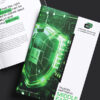
Brochures are more than just folded pieces of paper—they’re powerful marketing tools that speak directly to your audience. But what makes one brochure memorable and another forgettable? Often, the secret lies in something deceptively simple yet profoundly impactful: color psychology.
In a bustling market like Dubai, the competition is fierce, and standing out means connecting emotionally with potential customers. This is where a skilled brochure design company Dubai steps in, helping you turn simple print materials into magnetic pieces that resonate with your audience.
Here are 8 creative ways you can harness color psychology to transform your brochures from ordinary to exceptional.
1. Make a Statement with Bold Colors
Bold colors like red, orange, or vibrant blue aren’t just eye-catching; they communicate confidence, excitement, and trust. If you’re targeting Dubai’s vibrant market, working with an experienced brochure design company in Dubai can ensure that your brand stands out boldly against competitors. Bold shades convey a sense of innovation, capturing attention and emphasizing your brand’s unique personality.
2. Understand Local Color Meanings
In Dubai, colors carry deep cultural significance. For instance, green symbolizes prosperity and growth, while gold represents luxury and prestige. Collaborating with a professional brochure design company Dubai can ensure your color choices align perfectly with local values, enhancing credibility and resonance with your target audience.
3. Improve Readability with Contrast
An impressive design is pointless if your audience struggles to read your content. Expert designers at top brochure design companies in Dubai prioritize contrast to make sure your message stands out clearly. High-contrast colors (like dark blue text on a white background) instantly boost readability and keep your audience engaged longer.
4. Use Colors to Trigger Emotions
Colors can strongly influence how people feel about your brand. Warm tones like yellow and orange create a welcoming atmosphere, ideal for hospitality brochures. Cooler tones such as blues and greens inspire trust and relaxation—perfect for healthcare or financial services. A skilled brochure design company will strategically use these emotional cues to convey your brand’s personality effectively.
5. Stay Trendy with Seasonal Palettes
Dubai’s fast-paced lifestyle demands staying current with seasonal trends. Seasonal colors demonstrate that your brand is fresh, relevant, and aware of trends. Whether it’s vibrant summer hues or cooler winter shades, expert brochure designers in Dubai ensure your materials always stay timely without losing brand identity.
6. Minimalism Speaks Loudly
Sometimes less really is more. A minimalist brochure using two to three complementary colors creates a modern, luxurious look. Many upscale brands in Dubai opt for minimalist color schemes—whites, muted greys, and subtle pastels—to emphasize sophistication and clarity. Partnering with a top brochure design company allows you to strategically implement minimalism that highlights your key message.
7. Signature Colors for Brand Personality
Defining signature colors unique to your brand personality enhances memorability. Just as Coca-Cola’s iconic red is instantly recognizable, your brand too can benefit from choosing one or two primary colors that reflect your brand ethos clearly. Leading brochure design companies in Dubai specialize in finding the ideal shades that speak volumes about your brand identity and make your brochures uniquely yours.
8. Partner with Professional Designers
Color psychology, while powerful, can be complex. Working with professionals from a reliable brochure design company Dubai simplifies the process, providing expert guidance based on experience. Specialists will help select palettes that align perfectly with your marketing goals, audience preferences, and Dubai’s market dynamics.
Why Choose Brochuredesign.ae for Your Next Project?
As a leading brochure design company in Dubai, Brochuredesign.ae brings unmatched creativity, local insight, and professional expertise to every project. With over 15 years of experience, our skilled team—comprising graphic designers, creative copywriters, and Arabic translation experts—delivers tailored brochure designs that speak directly to your customers. From concept to print, our customized approach ensures your brochures aren’t just beautifully designed—they deliver measurable results.
Conclusion
Incorporating color psychology effectively in your brochure design is crucial to capturing attention, driving engagement, and elevating your brand’s identity. With these 8 creative strategies and expert support from the right brochure design company, your brochures won’t just be visually appealing—they’ll become powerful marketing assets that your audience can’t ignore.







